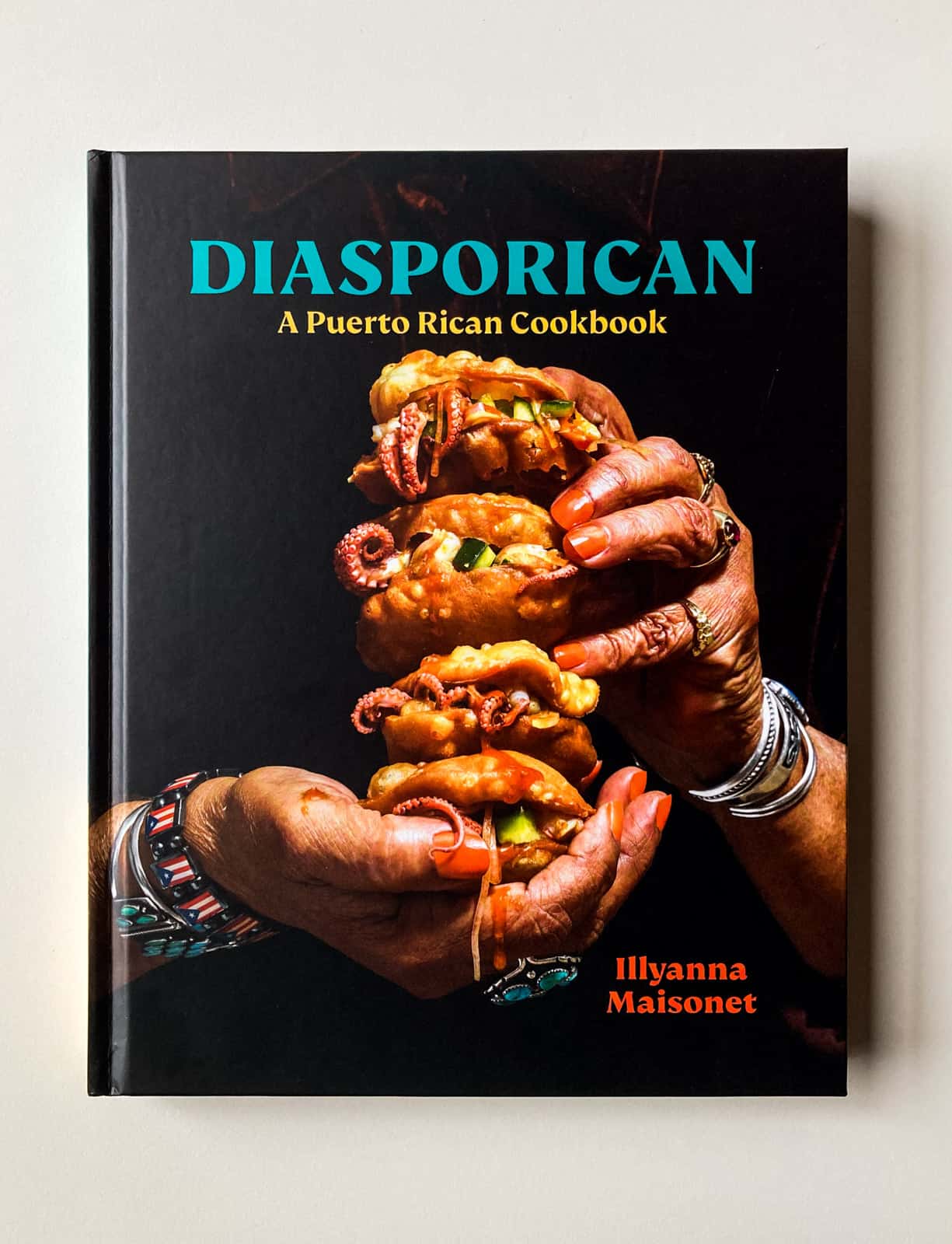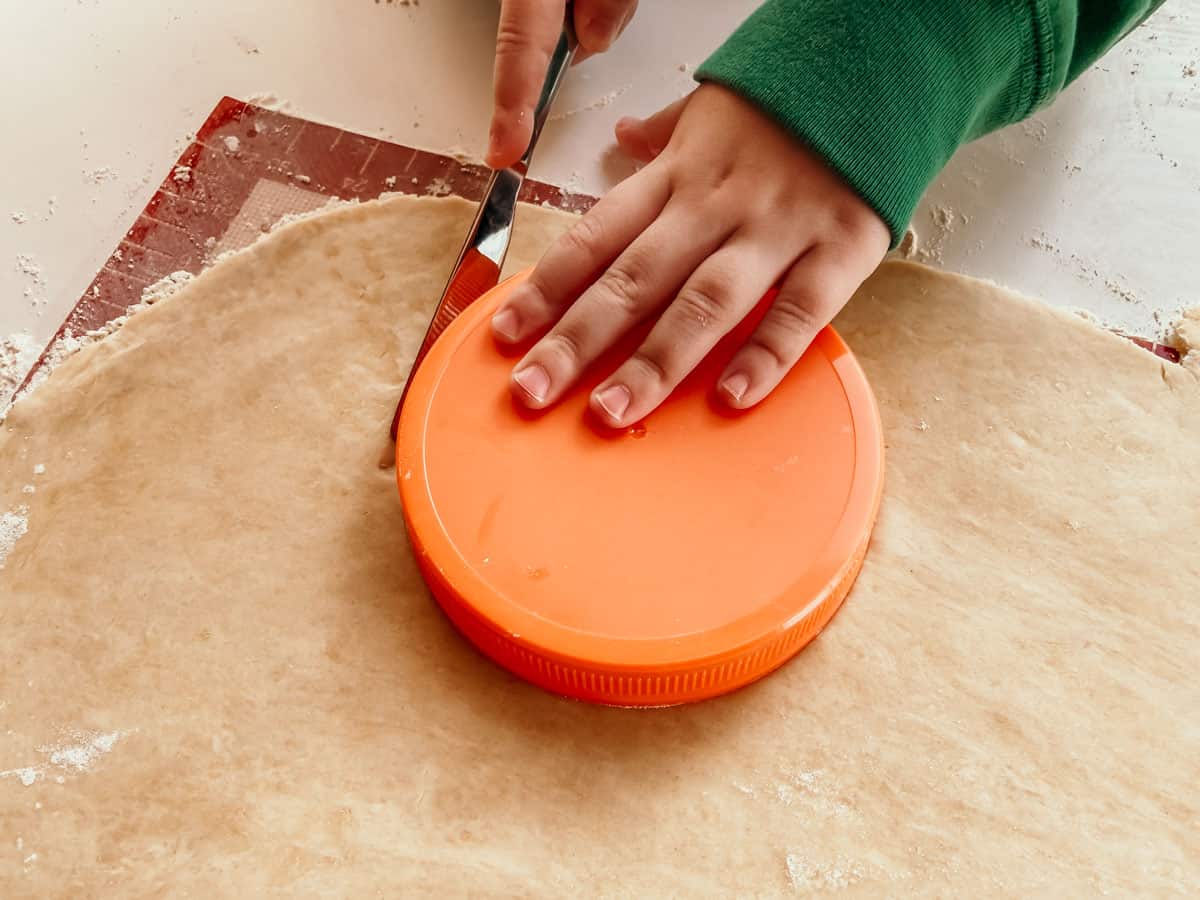
"The battle of what to call the empanada...much like many other things in Puerto Rico, to claim their own (and not cede to the Spanish or Americans), Puerto Ricans call empanadas either empanadillas or pastelillos."
- Illyanna Maisonet
These empanadillas are phenomenal and we can't wait for you to try them. We had such a great time making them together and Noah even gives a demo on how to fold the empanadilla dough.
Check out the demo and grab a free recipe to try at home. It's waiting for you down at the bottom or you can use the table of contents below.
If you like empanadillas, you'll love sofrito, picadillo, mallorcas, sambusas, and Boiko-style knish.
Learn more about how to cook with kids.
Disclosure of Material Connection: Some of the links in the post are “affiliate links.” This means if you click on the link and purchase the item, I will receive an affiliate commission. Amazon links are not affiliate links. You can read my full affiliate disclosure.

This easy empanadilla recipe comes from Diasporican: A Puerto Rican Cookbook by Illyanna Maisonet.
Illyanna is the first Puerto Rican food columnist in the U.S. Her cookbook, Diasporican, contains over 90 recipes. Everything about it, from the food, family, and landscape photography to the history and wit, welcomes you in and invites you to explore.
In Diasporican, Illyanna discusses empanadas, empanadillas, and pastelillos:
The empanada is mentioned, possibly for the first time in print, in a book originally called Libre del Coch, which was published in 1520 and written in Catalan by an author named Mestre Robert, later known as Ruperto de Nola. These recipes would be plagiarized by Diego Grenado in his 1599 book Libro del Arte de Cozina. During the period in which the book was written, empanadas were a pie made with bread dough, or en pan, which translates to "in bread," with top and bottom crusts made of well-sifted white flour, cold water, salt, and a little manteca, whereas pastelillos had a bottom crust made of lard-based pie dough and a top crust of hojaladre, or leaf-pastry. Two different doughs for the empanada and pastelillo. While most people use premade empanada wrappers from the frozen section of the market, the preferred fillings in Puerto Rico are still picadillo (a bracingly flavorful ground beef mixture filled with sofrito and tomato sauce) and jueyes (stewed land crab).
- Illyanna Maisonet
She goes on to write that nowadays, you can also find empanadillas with pizza-inspired fillings or braised chicken and melted cheese.
Pair the recipes in Diasporican with Illyanna's custom adobo and sazón blends to create flavorful Puerto Rican food at home.
You can find more delicious recipes by Illyanna Maisonet over at Eat Gorda Eat.
Learn more about Illyanna and Diasporican.
Family & Kids' Cooking Resources
Beautiful and diverse cooking resources for you!

You can also stop by our shop to see more Family & Kids' Cooking Resources.

Free Cooking Course for Families
Combine your efforts and discover recipes for every continent! Sign up to receive free cooking lessons for the whole family. Learn from some of the most talented chefs around the world, including Illyanna Maisonet, and participate in the quality practical life experiences Montessori education is known for.

Pastelillos vs Empanadillas: What's the Difference?
In Diasporican, Illyanna writes:
There are hundreds of Puerto Ricans prepared to throw hands if I call empanadillas empanadas. But that's what empanadillas are and they originate from the same cuisine. It doesn't take a rocket scientist to take one look at this deep-fried pastry pocket, filled with meat and sometimes crab or a sweet offering, to recognize its Spanish ancestor, the empanada. Depending to whom you speak and on which part of the island, the empanada is called an empanadilla if the dough is sturdier and the decorative seal is rope-style. It's a pastelillo if the dough is delicate and flaky and sealed with fork tines. By the way, it's called a taco if it's tri-folded like a letter. There's also a puff pastry dessert that has neither a rope nor a tine-seal that is called pastelillo de guayaba.
And if you were my Puerto Rican grandma living in Sacramanto during the 1950's, you would just use a tortilla in place of the dough and deep-fry it for your own version of a taco. Although that would be called a chimichanga.
- Illyanna Maisonet
The above photo is just one example of the creativity and beauty you'll find throughout this cookbook.
Wondering What to Use for Empanadilla Dough?
We'll show you how to make the empanadilla dough in this recipe. You can also pick up some empanada dough from the freezer section of an international market or rolled pie crusts from the refrigerated section of your local market.
Empanadillas Recipe

Ingredients
- flour - we prefer all-purpose einkorn. It's easy to work with and tastier than some other flours we've used in the past
- salt - we like this pink Himalayan salt
- vegetable shortening or manteca - if you don't have either of these you can follow the recipe card at the bottom which uses butter
- water - this recipe calls for ½ cup of water. If you use butter like we did, you may end up around ¾ cup instead. The water should be very cold or have a couple ice cubes in it
- picadillo - make homemade picadillo with this recipe, also from Diasporican cookbook
- oil - the recipe calls for canola oil, but you can also try olive oil as we did, coconut oil, etc.
Equipment
- prep bowls
- kitchen scale
- silicone baking mat
- measuring cup
- plastic wrap
- rolling pin
- container lids
- sheet pan
- cooling rack
- pan
- digital thermometer

1. Weigh the Flour
Wash your hands with soap and water. Use a kitchen scale to weigh the flour needed for making the empanadilla dough.

2. Add the Salt
Add a pinch of salt to the flour.

3. Add the Butter
Use your hands or a pastry cutter to cut the butter into the flour.

4. Gradually Add Water
Gradually add the water to the bowl. If you have ice cubes in your water, you can remove them before you pour the water in. Use your hands to combine the ingredients.

5. Knead and Rest
Knead the empanadilla dough for about 3 minutes or so. Form a disc-shape and place it in a clean bowl. Cover the bowl with plastic wrap and place the bowl in the fridge for 15 - 20 minutes.


While the dough is resting, you can flour your work surface. Ours is a silicone baking mat.

6. Roll Out the Dough
Use a rolling pin to roll out the empanadilla dough to approximately ⅛ inch thick.

7. Cut the Dough Into Large Circles
Use a biscuit cutter or a large container lid along with a butter knife to cut the dough into circles.

We used a couple of yogurt lids and a coconut oil lid. Lots of fun.


If you're looking to amp up the fun, kids can practice working with a tortilla press to create the wrappers. The tortilla press is also great for making sambusas, shumai, and of course, tortillas, tostadas, and more.
Using this method, kids will roll small sections of dough into balls and use the tortilla press to flatten them into empanadilla wrappers.

8. Add the Picadillo and Fold the Dough Over
Place 1 or 2 tablespoons of picadillo on top of each dough circle and fold the circles in half.

9. Seal the Dough
Use your fingers to press down on the edges of the dough. Grab a fork and press the tines into the seam to create a seal.
You can also repeatedly fold small sections along the seam to create the rope-like appearance seen in the photo from the cookbook, at the top of the page.
How to Fold Empanadillas
Watch the video to see Noah demonstrate how to fold empanadillas.

One of my favorite views.

10. Fry the Empanadillas
Set a baking sheet with a wire cooling rack next to the stove. Turn the stove on medium-high. Add the oil to the cast iron skillet. Add enough oil so that it sits about 2 inches high in the skillet.
Use a digital thermometer to check the temperature of the oil. When it reaches 350 degrees Fahrenheit, you can add some empanadillas to the skillet. Fry the empanadillas in the oil for 3 to 5 minutes on each side.

11. Transfer them to a Cooling Rack
Once the empanadillas are a deep golden brown on each side, transfer them to the cooling rack. Repeat until all the empanadillas are cooked. Turn off the stove.

Serve immediately with your favorite dipping sauce.

Free Empanadillas Recipe for Pre-Readers and Up
Grab your free printable recipe cards above. Kids can gather ingredients using the ingredient list, gather their equipment with the tools list, and prepare the meal using the step-by-step recipe cards, with assistance as needed.
The cards are easy to use, include pictures, and encourage confidence and independence in the kitchen. They also make an excellent addition to your Montessori continent box for North America.
Montessori Continent Boxes
Explore every continent with these solid maple hardwood boxes.


Empanadillas
Equipment
- Plastic Wrap
- Large Container Lids
Ingredients
- 2½ cups all-purpose einkorn flour
- 1 pinch kosher salt
- ½ cup unsalted butter
- ¾ cup water cold
- 1¼ cups picadillo
- olive oil for frying
Instructions
- Wash your hands with soap and water. Use a kitchen scale to weigh the flour needed for making the empanadilla dough.
- Add a pinch of salt to the flour.
- Use your hands or a pastry cutter to cut the butter into the flour.
- Gradually add the water to the bowl. If you have ice cubes in your water, you can remove them before you pour the water in. Use your hands to combine the ingredients.
- Knead the empanadilla dough for about 3 minutes or so. Form a disc-shape and place it in a clean bowl. Cover the bowl with plastic wrap and place the bowl in the fridge for 15 - 20 minutes. While the dough is resting, you can flour your work surface.
- Use a rolling pin to roll out the empanadilla dough to approximately ⅛ inch thick.
- Use a biscuit cutter or a large container lid along with a butter knife to cut the dough into circles.
- Place 1 or 2 tablespoons of picadillo on top of each dough circle and fold the circles in half.
- Use your fingers to press down on the edges of the dough. Grab a fork and press the tines into the seam to create a seal. You can also repeatedly fold small sections along the seam to create a rope-like appearance.
- Set a baking sheet with a wire cooling rack next to the stove. Turn the stove on medium-high. Add the oil to the cast iron skillet. Add enough oil so that it sits about 2 inches high in the skillet. Use a digital thermometer to check the temperature of the oil. When it reaches 350 degrees Fahrenheit, you can add some empanadillas to the skillet. Fry the empanadillas in the oil for 3 to 5 minutes on each side.
- Once the empanadillas are a deep golden brown on each side, transfer them to the cooling rack. Repeat until all the empanadillas are cooked. Turn off the stove. Serve immediately with your favorite dipping sauce.
Notes
- Never leave cooking food unattended
- Always have good ventilation when using a gas stove
- See more guidelines at USDA.gov.
- Full Recipe Info and Pictures at: https://happyhomeschooladventures.com/empanadillas
Nutrition
Estimated nutrition information is provided as a courtesy and is not guaranteed.





Leave a Reply